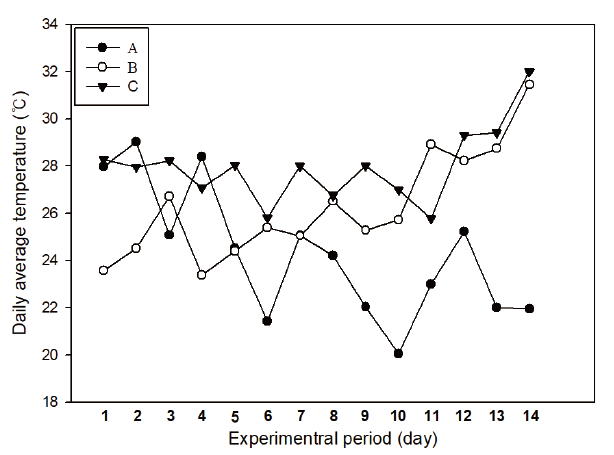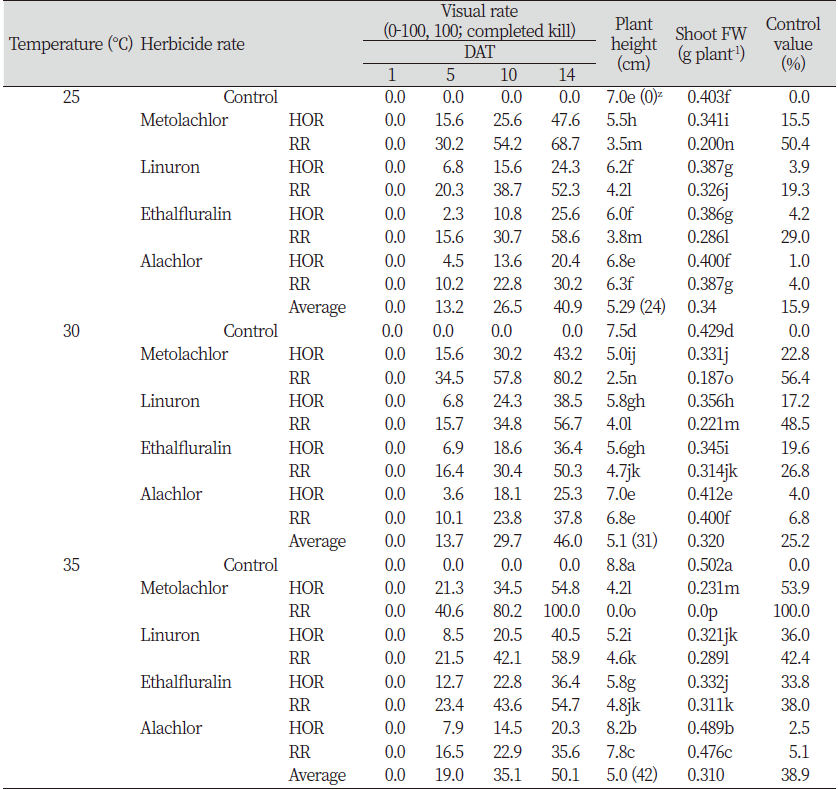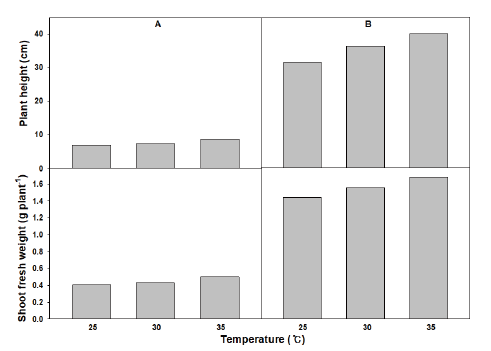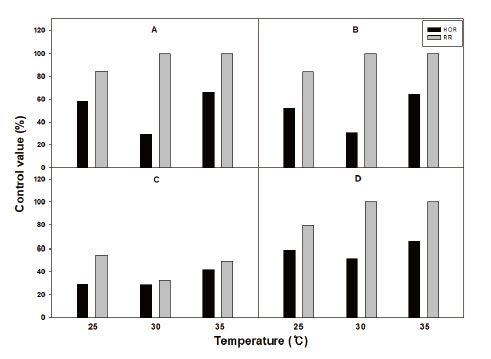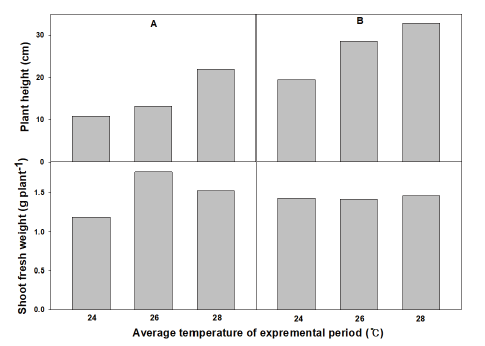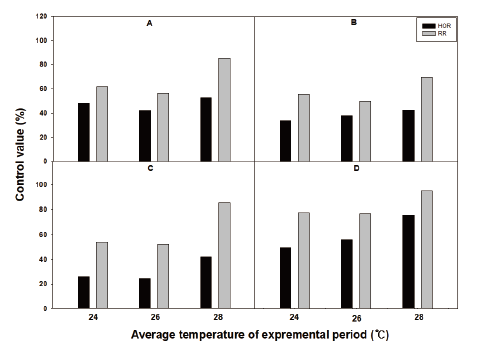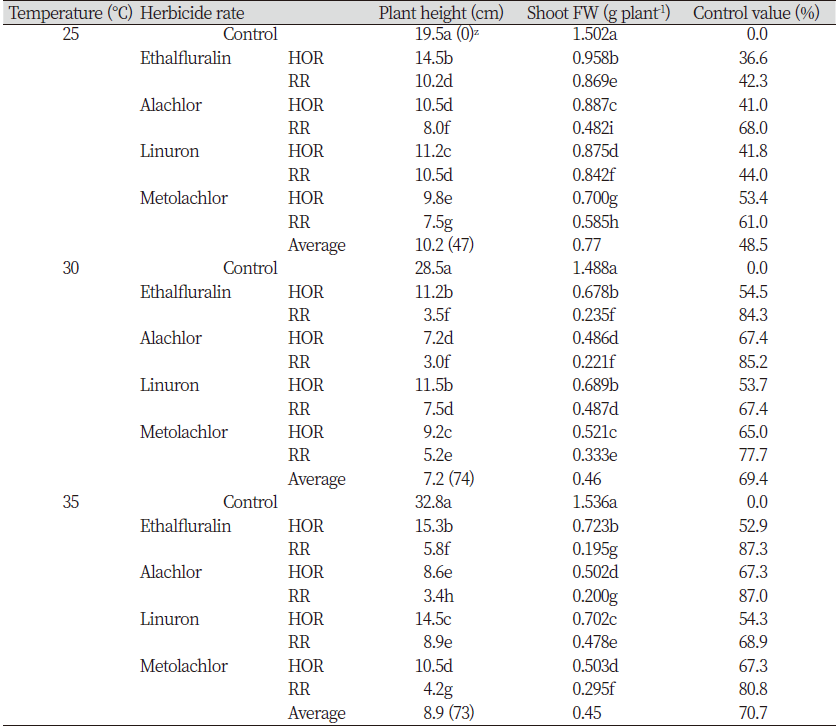서 언
기후 변화는 온도 상승이 수반되고(Gillett et al., 2011; Tubiello et al., 2007), 강수량 패턴 변화로 여름 가뭄 가능성이 증가하고 있다(Bloomfield et al., 2006; Lobell and Burke, 2008; Robinson and Gross, 2010). 이러한 기후변화는 작물재배지, 잡초, 병충해, 토양비옥도 변화 등 농업생산성에 간접적인 영향을 주게 될 뿐만 아니라 광합성, 물의 이용효율 등에 영향하여 작물의 생산성에 직접적인 영향을 미칠 것으로 예상된다.
기후변화는 잡초에 직·간접적으로 영향을 미친다. CO2와 온도의 증가는 더 문제시되는 새로운 잡초가 발생하고 기존 잡초는 많은 지역으로 확산될 것이다(Dukes et al., 2009; Singer et al., 2013). 예를 들어, 더 습하고 온화한 겨울은 일부 동계일년생 잡초의 생존율을 높이는 반면 더 따뜻한 여름과 더 긴 생육기는 더 북쪽지역에서 하계일년생을 자라게 허용할 수 있다(Bloomfield et al., 2006; Hanzlik and Gerowitt, 2012; Walck et al., 2011). 기후변화로 온도가 상승하면 작물보다도 대부분 C4 식물인 잡초들이 더욱 민감하게 반응을 하기 때문에 기존 농경지에서 발생 초종 및 우점도가 변화할 것으로 예상된다(Allena and Brucey, 2016; Aruna and Jugulam, 2016; Ziska, 2016). 실제로 평균온도 3℃ 증가는 itch grass (Rottboelliia cochinchinensis)의 생물체량과 엽면적이 각 88%와 68% 증가하였다(Patterson et al., 1999).
기후변화에 따른 온도상승은 제초제 처리에 의한 작물 약해와 잡초 방제효과에도 많은 영향을 미칠 것으로 예상된다. 대부분 제초제들은 온도가 상승할수록 흡수가 높아지고, 이행과 대사가 빨라진다(Kim et al., 1989; Park et al., 1991; Pyon et al., 1994). 또한 온도가 상승하면 잡초의 발아 및 생육이 빠르기 때문에 제초제 흡수량이 증가하여 약효도 조기에 나타나고, 대체적으로 약효도 증가한다(Kim et al., 2005). 그러나 제초제에 의한 잡초의 약효증가는 작물에 약해를 발생시킬 가능성이 매우 높다. 최근 제초제 저항성 잡초 증가로 국내 논에서 주로 사용되고 있는 benzobicyclon 등 HPPD (4-hydroxyphenylpyruvate dioxygenase) 저해제들에 대한 약해민원이 증가하고 있는데, 이는 온도가 상승함에 따라 약해가 더 심하게 나타나기 때문이다(Kwon et al., 2012).
제초제 효율에 대한 기후 변화의 영향을 파악하기 위해 환경 조건이 어떻게 제초제 효과에 영향을 미치는지 이해하는 것이 중요하다. 제초제의 성공적인 사용은 제초제 사용 전 후 및 동안 환경 조건에 달려 있다. 환경은 식물의 생장과 생리뿐만 아니라 제초제와 식물과 제초제 사이의 상호 작용에 영향을 미친다(Aruna and Jugulam, 2016; Kudsk and Kristensen, 1992). 빛, CO2, 온도, 토양 수분, 상대 습도, 강우, 바람과 같은 환경 요인은 식물내에 제초제 침투와 이행의 변화에 의해 또는 식물의 생장과 생리적 특성 변화에 의해 직, 간접으로 제초효율에 영향을 미친다.
기후변화와 국제 교역의 확대 등으로 농경지 내 외래잡초 발생이 증가하는 것으로 확인되었다(Kim et al., 2017). 외래잡초은 주로 종자 생산량도 많고 초기생장이 빨라 경합력이 높기 때문에 생물다양성을 훼손시킬 뿐만 아니라, 인간 활동을 제한하며 건강을 위협하는 요인이 되고 있다(Andow, 2003). 우리나라 및 일본에서 둥근잎유홍초는 콩밭과 같은 밭작물재배지에서 발생량이 증가하고 있다(Seo, 2010). 또한 둥근잎유홍초는 생육이 왕성하고 신속하며 종자 생산량도 많기 때문에 방제방법이 단순하지 않아 농작물 수량감소에 영향을 미칠 것으로 예상된다.
기후변화에 의한 일부 잡초종은 현재보다 강한 생육과 번식력을 갖게 되어 작물 생육에 크게 영향을 미칠 것으로 예상된다. 따라서 기존의 잡초방제법 적용은 그 효과가 현저히 감소할지도 모른다. 이러한 문제를 해결하기 위하여 새로운 방제기술을 개발해야 한다. 따라서 본 연구는 온도상승에 의한 주요 토양 및 경엽처리제 제조제에 대한 외래 잡초 둥근잎유홍초에 대한 약효반응을 평가하여 추후 기후변화에 따른 방제기술을 개발하는데 활용하고자 수행하였다.
재료 및 방법
식물재료 및 제초제
본 실험에 사용된 둥근잎유홍초(Quamoclit coccinea Moench) 종자는 전라남도 순천시 순천대학교 서면 농장에서 2017년 11월에 채집하여 종자를 정선하여 실험에 사용(2020년 4월) 할 때까지 4℃ 저온냉장고에서 보관하여 사용하였다. 본 연구에 사용한 토양 및 경엽처리제 각각 4종을 사용하였고, 사용한 제초제 제제, 유효성분, 사용약량, 살포량 등은 Table 1에 제공하였다.
생장상조건하에서 온도조건별 둥근잎유홍초 제초제 약효반응
둥근잎유홍초 종자를 플라스틱 컵(150 mL)에 5립씩 1 cm 깊이로 파종하여 25℃로 조절된 생장상(Multi-room Incubator, VS-1203PFC-LN, Vision Bionex, Buchon, Korea)에 두었다. 그 밖의 생장상 조건은 상대습도 70%, 광주기 12/10시간(주/야), 광량(100 µmol m-2 s-1)으로 하였다. 파종 후 3일에 토양처리제 ethalfluralin, metolachlor, linuron 및 alachlor를 처리하였다. 처리 후 위와 동일한 생장상을 이용하여 25, 30, 35℃로 조절된 생장상에 두었다. 처리 후 1, 5, 10, 14일째에 달관평가(0-100, 100; 완전고사)하였고, 처리 후 14일째에는 초장과 생체중을 조사하고 무처리 대비 생체중으로 방제가를 산출하였다.
경엽처리제 bentazone, glufosinate-ammonium, glyphosate-isopropylamine, mecoprop 처리의 경우 둥근잎유홍초 파종 후 플라스틱 컵(150 mL)당 3개체로 유지하여 위의 토양처리와 동일하게 처리 전까지는 25℃로 조절된 생장상에 두었다. 파종 후 14일째(3-4엽기)에 경엽처리제를 처리하고 위와 동일하게 25, 30, 35℃로 조절된 생장에 두었다. 조사방법은 위의 토양처리와 동일하게 하였다.
온실조건하에서 온도조건별 둥근잎유홍초 제초제 약효반응
둥근잎유홍초 종자를 사각포트(18 cm×13 cm)에 10립씩 파종하여 실험기간 평균온도가 24℃로 조절된 온실조건에 두었다. 그 밖의 온실 조건은 평균적으로 상대습도 60%, 광주기 12/10시간(주/야), 광량(500 µmol m-2 s-1)으로 하였다. 파종 후 3일에 토양처리제 ethalfluralin, metolachlor, linuron 및 alachlor를 Table 1과 같은 조건으로 처리하였다. 처리 후 처리기간(14일)에 온실의 평균온도는 각각 24, 26, 28℃이었다(Fig. 1). 처리기간 평균온도는 온습도 데이터로거(SK-L200TH, SATO, Tokyo, Japan)로 측정하였다. 처리 후 14일째에는 초장과 생체중을 조사하고 생체중에 기초한 방제가를 산출하였다. 경엽처리제 bentazone, glufosinate-ammonium, glyphosate-isopropylamine, mecoprop 처리의 경우 둥근잎유홍초 파종 후 위와 동일한 사각포트당 6개체로 유지하여 위의 토양처리와 동일하게 처리 전까지는 평균온도가 24℃로 조절된 온실조건에 두었다. 파종 후 14일째(3-4엽기)에 경엽처리제를 처리하고 위와 동일하게 평균온도가 각각 24, 26, 28℃로 조절된 온실조건에 두었다. 조사방법은 위의 토양처리와 동일하게 하였다.
Table 1. Herbicides used in this study.

|
|
EC: Emulsifiable concentrates; WP: Wettable powder; L: Liquid; DAS: Days after seeding. |
통계처리
본 실험은 완전임의 배치 3반복으로 하였으며, 실험결과는 SAS (2000) 통계분석 DMRT (Duncan’s multiple range test) 검정(P=0.05)을 실시하여 유의성 유무를 확인하였다.
결과 및 고찰
생장상조건하에서 온도조건별 둥근잎유홍초 제초제 약효반응
제초제 처리시 환경조건은 잡초의 제초효과에 아주 중요하게 영향을 미친다. 이러한 환경조건에는 광, 수분, 습도, 온도 바람속도 등이 있다. CO2 증가 또는 고온과 같은 기후요인에 의한 변화는 제초제의 화학특성 변화를 초래하여 궁극적으로 식물에서 제초제 침투와 이행에 영향을 미친다. 추가적으로 식물의 생장과 생리에 변화는 제초제와 식물표면의 상호작용 능력이 결정될 것이고, 식물 내부로 이행되어 작용점 도달에 영향을 미친다(Arunaand Jugulam, 2016; Kudsk and Kristensen, 1992). 생장상의 온도조건별(25, 30, 35℃ 항온) 토양처리제 제초제 ethalfluralin, metolachlor, linuron 및 alachlor를 처리 후 1, 5, 10 및 15일째 달관평가 결과 둥근잎유홍초 제초 효과는 제초제별로 다르나 모든 제초제에서 처리 후 시간이 경과할수록 증가하였다(Table 2). 25℃ 생장상에서 제초효과의 경우 토양처리제 중 metolachlor 표준량처리에서 69% 방제가를 보여 가장 높았으나, alachlor의 경우는 표준량 처리에서도 30% 방제가를 보여 가장 낮았다. 30℃ 생장상에서 제초효과의 경우 25℃ 결과와 유사하게 토양처리제 중 metolachlor 표준량 처리에서 80% 방제가를 보여 가장 높았고, alachlor 표준량 처리에서는 단지 38% 방제가를 보였다. 35℃ 생장상에서 제초효과의 경우 25℃ 및 30℃ 생장상의 결과와 유사하게 metolachlor 표준량처리에서 방제가가 가장 높았고, alachlor에서 낮았다. 토양처리제 제초제 처리에 의해 둥근잎유홍초 초장은 생장상의 온도조건에 상관없이 무처리에 비해 유의적으로 감소하였다. 그러나 생장상의 온도(25, 30, 35℃)가 증가할수록 토양처리제 처리에 의한 둥근잎유홍초 초장의 저해 정도는 큰 것으로 나타났다. 토양처리제 처리에 의한 둥근잎유홍초 지상부 생체중에 기초한 방제가는 앞의 달관평가 및 초장의 결과와 유사하게 생장상의 온도가 증가할수록 방제가는 높았다(Fig. 2). 그러나 지상부 생체중에 근거한 방제가는 달관평가 및 초장에 비해 낮았다. 토양처리제 alachlor 처리에 의한 둥근잎유홍초는 생장상의 온도조건에 상관없이 거의 방제되지 않았다. 그러나 ethalfluralin, metolachlor 및 linuron 처리에 의한 둥근잎유홍초 방제가는 생장상의 온도가 증가할수록 증가하였다. 특히, metolachlor 표준량 처리의 경우 둥근잎유홍초는 생장상 25℃ 조건하에서 50% 그리고 생장상 35℃ 조건하에서 100% 방제 되었다. 전반적으로 토양처리제의 경우 둥근잎유홍초 방제가는 낮았으나 처리시 생장상의 온도가 증가할수록 방제효과도 증가하는 경향이었다. 또한 무처리 조건의 생장상의 온도가 증가할수록 초장과 지상부 생체중이 증가하였다(Fig. 3A). 토양처리제의 경우 생장상의 온도가 높을수록 약효가 증가했던 것은 온도가 상승하면 잡초의 발아 및 생육이 빠르기 때문에 제초제 흡수량이 증가하여 약효도 조기에 나타나고, 대체적으로 약효도 증가한다는 결과(Kim et al., 2005)와 유사하는 것으로 해석된다.
생장상의 온도조건별(25, 30, 35℃ 항온) 경엽처리제 제초제 bentazone, glufosinate-ammonium, glyphosate-isopropylamine 및 mecoprop를 처리 후 1, 5, 10 및 15일째 달관평가 결과 둥근잎유홍초 제초 효과는 제초제별로 다르나 모든 제초제에서 처리 후 시간이 경과할수록 증가하였다(Table 3). 25℃ 생장상에서 제초효과의 경우 경엽처리제 중 bentazone과 mecoprop 표준량처리에서 각각 83%와 77% 방제가를 보여 가장 높았다. 30℃와 35℃ 생장상에서 제초효과의 경우 경엽처리제 중 bentazone과 mecoprop 표준량처리에서 100% 방제가를 보여 다른 제초제에 비해 높은 방제가를 보였다. 전반적으로 달관에 의한 경엽처리제 제초효과의 경우 생장상의 온도가 증가할수록 증가하였다.
경엽처리제 처리에 의해 둥근잎유홍초 초장은 생장상의 온도조건에 상관없이 무처리에 비해 유의적으로 감소하였다. 그러나 초장 저해정도는 생장상의 온도(25, 30, 35℃)간에 큰 차이가 없었으나 경엽처리제 처리에 의한 둥근잎유홍초 초장 저해는 달관평가 보다 높게 나타났다. 경엽처리제 처리에 의한 둥근잎유홍초 지상부 생체중에 기초한 방제가는 25℃와 30℃ 생장상 간에는 유사하였으나 35℃ 생장상의 경우는 이들 온도에 비해 방제가가 높았다(Fig. 4). 경엽처리제 glyphosate-isopropylamine 처리에 의한 둥근잎유홍초는 생장상의 온도조건에 상관없이 방제가는 큰 차이가 없었다. 또한 glyphosate-isopropylamine 처리의 경우 다른 제초제에 비해 방제가 낮은 이유는 본 연구에서 처리 후 14일에 방제가를 조사하였으나 이 제초제는 제초효과가 늦게 나타나기 때문일 것으로 사료된다. 그러나 bentazone, glufosinate-ammonium 및 mecoprop 처리에 의한 둥근잎유홍초 방제가는 생장상의 온도가 증가할수록 증가하였다. 특히, bentazone, glufosinate-ammonium 및 mecoprop 표준량 처리의 경우 둥근잎유홍초는 30℃와 35℃ 생장상 조건하에서 100% 방제 되었다. 전반적으로 볼 때 둥근잎유홍초 방제는 앞의 토양처리제에 비해 경엽처리제에서 훨씬 높게 나타났다. 또한 일부 제초제를 제외하고 생장상의 온도가 증가할수록 방제 효과는 높게 나타나는 경향이었다. 온도증가에 의한 식물생장량 증가는 식물에 흡수된 경엽처리제초제 양을 희석할 수 있다. 결국 작용점에 결합하여 식물을 죽일 수 있는 제초제 잔류량에 감소를 초래한다(Aruna and Jugulam, 2016). 예를 들면 식물 생장량과 엽면적의 증가는 풍부한 CO2 수준하에서 외래잡초 rhodes grass (Chloris gayana)와 dallisgrass (Paspalum dilatatum)의 경우에는 glyphosate 약효가 떨어지게 하였다(Manea et al., 2011). 그러나 본 연구에서 온도가 증가할수록 둥근잎유홍초에 대한 제초제 약효가 증가하였기 때문에 온도상승에 따른 생장량 증가보다는 다른 요인에 의해 기인되는 것으로 사료된다(Fig. 3B). 본 연구와 제초제는 다르나 flumiclorac은 명아주(7배) 및 비름(3배)은 온도가 10℃에서 40℃로 증가할수록 제초활성이 높게 나타났다(Fausey and Renner, 2001). 비록 높은 대기온도는 대부분 경엽처리제초제의 흡수와 이행 속도를 증가시키는 경향이 있으나 어떤 경우에 고온조건은 빠른 대사를 유도하여 결국 타켓식물의 제초활성을 감소한다(Johnson and Young, 2002; Kells et al., 1984).
온실조건하에서 온도조건별 둥근잎유홍초 제초제 약효반응
실험기간 평균온도(24, 26, 28℃)가 다른 온실조건하에서 토양처리제 제초제 ethalfluralin, metolachlor, linuron 및 alachlor를 처리 후 14일째에 초장과 지상부 생체중을 조사하였다(Table 4). 둥근잎유홍초 초장의 경우 실험기간 모든 온도조건의 모든 토양처리제 제초제에서 처리 후 유의적으로 감소하였다. 실험기간 평균온도 24℃와 26℃의 온실 조건하에서 토양처리제 metolachlor 표준량 처리에서 각각 70%와 69% 방제가를 보여 다른 제초제에 비해 제초 효과가 높았다. 그러나 실험기간 평균온도 24℃와 26℃의 온실 조건 간에는 차이가 없었다. 실험기간 평균온도가 28℃의 온실 조건하에서 metolachlor 표준량 처리에서 86% 방제가를 보여 24℃와 26℃의 온실조건에 비해 높은 방제가를 보였다. 둥근잎유홍초 지상부 생체중의 경우 실험기간 모든 온도조건의 모든 토양처리제 제초제에서 처리 후 유의적으로 감소하였다(Fig. 5). 실험기간 평균온도 24℃의 온실조건하에서 방제가는 metolachlor에서 가장 높았고, linuron에서 가장 낮았다(Fig. 6). 실험기간 평균온도 26℃의 온실 조건하에서 방제가는 metolachlor에서 가장 높았고, alachlor에서 낮았다. 실험기간 평균온도 28℃ 조건하에서 방제가는 모든 토양처리 제초제에서 24℃와 26℃의 온실 조건에서 높았다. 특히 metolachlor 표준량 처리에서 96%로 다른 제초제에 비해 가장 높은 방제가를 보였다. 토양처리제 ethalfluralin, metolachlor, alachlor 및 linuron 처리에 의한 둥근잎유홍초 방제가는 실험기간의 평균온도가 증가할수록 증가하였다. 앞의 항온 조건하의 실험조건과 유사하게 실험기간 평균온도(변온) 증가에 따라 초장과 지상부 생체중(26℃ 제외)은 증가하여 높은 온도조건하에서 높은 방제가와 생장량 감소와 관련성은 적은 것으로 사료된다(Fig. 5A).
실험기간 평균온도(24, 26, 28℃ 변온)가 다른 온실 조건하에서 경엽처리제 제초제 bentazone, glufosinate-ammonium, glyphosate-isopropylamine 및 mecoprop를 처리 후 14일째에 초장과 지상부 생체중을 조사하였다(Table 5). 둥근잎유홍초 초장의 경우 실험기간 모든 온도조건의 모든 토양처리제 제초제에서 처리 후 유의적으로 감소하였다. 실험기간 평균온도 24℃의 온실 조건하에서 토양처리제 metolachlor 표준량 처리에서 초장의 감소가 가장 크게 나타났고 26℃와 28℃의 온실 조건하에서는 glufosinate-ammonium에서 가장 크게 나타났다. 그러나 일반적으로 실험기간 평균온도 24℃와 26℃ 조건 간에는 초장 감소 차이는 없었으나 이들 온도 조건은 평균온도 24℃의 온실 조건에 비해 초장의 감소정도는 컸다. 둥근잎유홍초 지상부 생체중의 경우 실험기간 모든 온도조건의 모든 경엽처리제 제초제에서 처리 후 유의적으로 감소하였다. 앞의 초장의 경우와 유사하게 실험기간 평균온도 24℃와 26℃ 조건 간에는 지상부 생체중에 근거한 방제가는 차이가 없었으나 이들 온도조건은 평균온도 24℃의 온실 조건에 비해 방제가가 높았다. 실험기간 온도조건별 방제가는 제초제 종류 간에는 다소 차이를 보였으나 4가지 경엽처리 제초제 모두 실험기간의 평균온도 24℃와 26℃의 온실 조건 간에 방제가는 차이가 없었다(Fig. 7). 그러나 실험기간의 평균온도 28℃의 온실조건하에서 경엽처리제 모든 제초제에서 24℃와 26℃의 온실조건에 비해 방제가 높았다.
온도증가에 의한 잡초 생장량에 증가는 잡초에 흡수된 경엽처리제초제 양을 희석할 수 있다. 결국 작용점에 결합하여 식물의 죽일 수 있는 제초제 잔류량에 감소를 초래할 수 있다(Aruna and Jugulam, 2016). 그러나 본 연구의 경우 실험기간의 평균온도가 증가할수록 초장이 증가하였고, 지상부 생체중은 평균온도 24, 26, 28℃의 온실 조건 간에 유사한 경향을 보여 경엽처리 제초제 제초효과가 평균온도가 높았던 것과 잡초 생장량 감소와 관련성은 낮은 것으로 사료된다(Fig. 5B). 그러나 어떤 경우 고온은 제초제의 뿌리 흡수를 풍부하게 하고 큐티클 점도와 분무 용액의 화학적 특성의 변화에 의해 확산된 제초제 양이 변할 수 있다(Miraglia et al., 2009; Price, 1983). 예를 들면 14C-glyphosate은 roundup ready 콩의 분열조직에서 15℃에서 보다 30℃에서 이행이 높았다. 즉 glyphosate 피해는 온도가 증가할수록 증가한다는 의미이다(Pline et al., 1999). 한편 어떤 경우에 고온은 제초제 빠른 대사를 유도하고 일부 항산화효소 활성증가로 활성산소종의 무독화하여 표적식물의 제초활성을 감소시키기도 한다.
결론적으로 생장상의 항온조건하에서 토양처리제 제초제에 의한 둥근잎유홍초의 방제가는 25<30<35℃ 순이었고, 경엽처리제 제초제는 25=30<35℃ 순이었다. 실험기간 평균온도가가 다른 온실 조건하에서 토양처리제 제초제에 의한 둥근잎유홍초의 방제가는 24=26<28℃ 순이었고, 경엽처리제 제초제는 24<26=28℃ 순이었다. 토양처리제에 의한 둥근잎유홍초의 방제가는 토양처리제 경우는 변온조건하에서 그리고 경엽처리제 경우는 항온과 변온 조건 간에 유사하였다. 따라서 본 연구결과로 볼 때 기후변화에 수반되는 온도상승에 따른 새로운 잡초방제 기술 개발이 필요할 것이다.
그러나 본 연구에서는 단일 초종에 대한 제초제에 약효를 검정하였으나, Park et al. (2017)의 연구에서는 온도상승과 일부 잡초 물달개비와 올챙이고랭이 등의 약효에는 크게 영향을 받지 않았고 강피와 같은 잡초종에서 온도상승과 제초제 약효 발현에는 차이가 있음을 발표하였다. 또한 벼의 경우 고온조건에서 제초제 처리시 상대적으로 낮은 온도조건에 비해 약해가 심하게 발생하였다(Park et al., 2017). 따라서 추후 다양한 잡초종을 대상으로 제초제 약효와 작물에 대한 안정성 연구가 병행되어야 할 것으로 사료된다.
요약
본 연구는 기후변화에 따른 온도상승에 의한 주요 토양 및 경엽처리제 제조제의 외래 잡초 둥근잎유홍초에 대한 약효반응을 평가하여 추후 기후변화에 따른 방제기술을 개발하는데 활용하고자 수행하였다. 토양처리제 제초제 처리시 생장상의 온도(25, 30, 35℃)가 증가할수록 둥근잎유홍초 방제가 높은 경향이었다. 토양처리제 alachlor 처리에 의한 둥근잎유홍초는 생장상의 온도조건에 상관없이 거의 방제되지 않았다. 그러나 ethalfluralin, metolachlor 및 linuron 처리에 의한 둥근잎유홍초 방제가는 생장상의 온도가 증가할수록 증가하였다. 경엽처리제 glyphosate-isopropylamine 처리에 의한 둥근잎유홍초는 생장상의 온도조건에 상관없이 방제가는 큰 차이가 없었다. 그러나 bentazone, glufosinate-ammonium 및 mecoprop 처리에 의한 둥근잎유홍초 방제가는 생장상의 온도가 증가할수록 증가하였다. 특히, bentazone, glufosinate-ammonium 및 mecoprop 표준량 처리의 경우 둥근잎유홍초는 30℃와 35℃ 생장상 조건하에서 100% 방제 되었다. 토양처리제 ethalfluralin, metolachlor, alachlor 및 linuron 처리에 의한 둥근잎유홍초 방제가는 실험기간의 평균온도(24, 26, 28℃)가 증가할수록 증가하였다. 경엽처리 제초제 경우 평균온도 24℃와 26℃의 온실 조건 간에 둥근잎유홍초 방제가는 차이가 없었다. 그러나 실험기간의 평균온도 28℃의 온실조건하에서 경엽처리제 모든 제초제에서 24℃와 26℃의 온실조건에 비해 둥근잎유홍초 방제가 높았다. 따라서 기후변화에 수반되는 온도상승에 따른 새로운 잡초방제 기술 개발이 필요할 것이다.
주요어: 기후변화, 둥근잎유홍초, 외래잡초, 잡초방제, 제초제
Acknowledgements
This work was carried out with the support of “Cooperative Research Program for Agriculture Science & Technology Development (Project No. PJ01483503)” Rural Development Administration, Republic of Korea. The authors acknowledge the help of Min Hee Park, Hyo Jin Lee, Se Ji Jang, Hee Kwon Kim, Byung Joon Jeong and Ok Gi Lee in weed cultivation.

